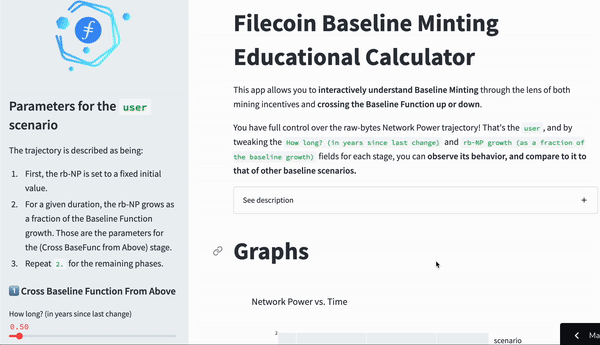Exploring Baseline Crossings: What Do They Mean for FIL Incentives?
This work is a continuation of the BlockScience x Filecoin collaboration, where we are building digital twin tooling to provide Computer-Aided Governance for the Filecoin ecosystem. This post explores how baseline crossing and network growth have behaved this past year and then uses the newly released, open-source Filecoin Baseline Minting Educational Calculator to explore hypothetical scenarios of baseline crossing to illustrate how Baseline Minting works.
Background Information
Filecoin has a unique economic model where minting is performed through a mixture of two processes: (1) Simple Minting, the standard exponential form widely used in cryptocurrency ecosystems and (2) Baseline Minting, which distributes rewards according to the existing network capacity (in bytes).
When the network is operating as intended, growth is rewarded with further growth through Baseline Minting; however, when unanticipated shocks occur — such as a sudden capacity constraint — Simple Minting allows participants to mitigate the effects of short-term volatility and allows the system to rebound smoothly as new storage is brought online.
Baseline Crossing Retrospective
It has been almost one year since The Baseline Crossing, a milestone for Filecoin sustainability where raw storage power exceeded baseline storage power for the first time. Since then, focus has shifted from generating raw storage power (in other words, capacity) to having meaningful storage capacity, which is occupied by usable data. Onboarding of meaningful data is driven by the Deal Marketplace and programs like Filecoin Plus.
These changes are reflected in the growth of Raw Byte Network Power which has shifted from an accelerating exponential form last year, to a more sustainable linear form this year, as is illustrated on the following figure. So far, all predictions made previously are consistent with the data being collected daily.
Effective Network Time
A key to understanding Baseline Minting is the Effective Network Time metric, an innovative concept that makes network time “go slower” when the Raw Byte Network Power is below the baseline function and “go faster” when it is catching up. Effective Network Time has several non-trivial implications impacting the economic incentives for mining, which is further explored on the Baseline Minting Incentives post.
The Filecoin Baseline Minting Incentives Calculator
To better understand these implications, BlockScience and Protocol Labs developed an Interactive Educational Calculator which lets the user select a variety of different scenarios and then see the possible results.
The user is able to adjust various Raw Byte Network Power scenarios and observe hypothetical network behaviors into the future. Among other scenarios, the user can examine what would happen if a shock occurs and the RB Network Power goes down.
For instance, consider the following figure as a reference case. In this example, the Raw Byte Network Power begins to shrink, crosses below the baseline, holds steady for some time, and then has explosive growth for five years until it approaches the baseline level again. What happens to the mining incentives in this hypothetical future?
The simple answer is provided by the Mining Utility Metric — an indicator of how profitable mining is when compared to a “baseline scenario” (an alternate reality where the Raw Byte Network Power is equal to the baseline function).
As of now, the Mining Utility Metric is around 0.5. If the Raw Byte Network Power starts shrinking, the Mining Utility Metric increases quickly, meaning existing miners will receive disproportionately large rewards.
The Role of Baseline Minting
The role of Baseline Minting is to generate the difference between the user and the user-baseline-deactivated scenarios by smoothing those early disproportionate rewards and then distributing them when the network gets close to the baseline in the future. In that sense, baseline minting provides a savings account to maintain a highly rewarding future!
Another approach is to simply estimate the total rewards due to Baseline Minting to be distributed per month given the alternative scenario. Total rewards due to Baseline Minting goes down when the baseline is crossed in a downward direction, and rises dramatically just before crossing upward again — far more than if there was no a baseline!
The above simulation result has implications for Network Security: suppose that for some reason the entire Filecoin Network is attacked, numerous sectors are shut off suddenly, and onboarding of new sectors is blocked — causing the RB Network Power to drop suddenly. Baseline Minting is a mechanism that will avoid disproportionately distributing the rewards to those that are still left.
Remaining miners will still be highly incentivized through both Simple and Baseline Minting, but not in such a way that threatens future token allocation.
Conclusions
There are many other insights to be gained through exploring alternate scenarios. How will the Effective Network Time behave? What happens if the baseline is never crossed again? What other interesting metrics can be created from those scenarios? The interactive calculator is available for anyone to use, with the option of downloading the raw simulation results as .csv once finished.
And of course, the entire calculator is all open source! Which means that the user can modify the underlying cadCAD model and generate even more complex simulations.
There’s a world of science to be uncovered at Filecoin. BlockScience has spent the last two years exploring the economic, operational, and security consequences of all pieces of this holistic complex system — offering the world a more trustworthy decentralized economy and utility provider.
After using the calculator and the open source repo, please don’t hesitate to share results! Use the #FilecoinBaselineCalculator tag, and let’s build community ownership of the knowledge around the incentives algorithms!
This article was written by Danilo Lessa Bernardineli and Will Wolf with edits and suggestions by Jeff Emmett, Alex Terrazas, Jamsheed Shorish, Jessica Zartler and ZX Zhang.


